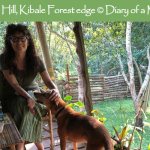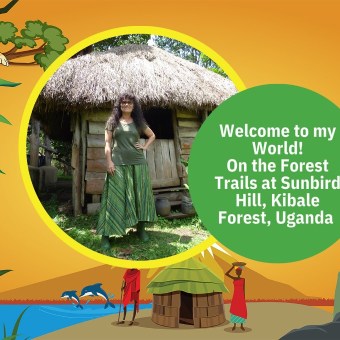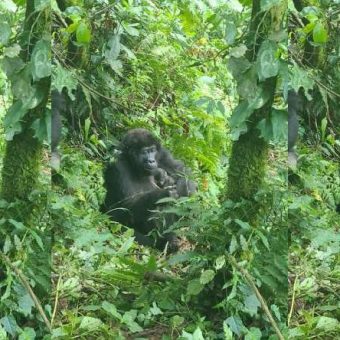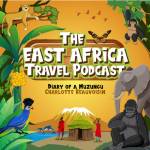
Early Sunday morning – when few people are around – is the best time to spot birds: through the slum, along the railway track, through the Papyrus down to Port Bell on Lake Victoria.
“Up with the lark” last Sunday for a spot of birdwatching with Roger and Jean. (Strangely, the lark was one of the few birds we didn’t see!) What a fantastic way to wile away a few hours.
Roger volunteers with Nature Uganda and gets paid to travel to every corner of Uganda to do bird counts. Nice job! His knowledge is amazing. Jean is a fellow VSO volunteer and is a midwife at Kibuli Hospital. He’s nuts about birds, she’s nuts about babies.
My house is separated from the marsh – and one of the city’s shanty towns – by the railway line a few metres beyond our compound wall. I love living in Namuwongo. I have the quiet of being in a cul de sac with the reassuring buzz of human activity beyond: men hammering iron sheet roofs onto new shelters, laughing children, salesmen broadcasting their (usually crappy Chinese) wares via the repetitive strain of Greensleeves played on a loop on cheap tinny speakers (did I mention crappy Chinese wares… ?) Except of course, it’s not always a buzz of activity out there but one – or many – loud pulsing rhythms. The drums and the sound of people ululating fill the night air on market days. Even after 18 months here it still sounds magical to me.
We are of course encroaching onto the wetlands. Our house is on legitimate land, the ‘right side’ of the railway, but nonetheless our house is surely part of the wider problem.
On our walk we lamented the loss of the wetlands (the natural filter for the heavy run-off from rains in Kampala for instance) but were delighted to see seven Grey-Crowned Cranes, Uganda’s national symbol. What does it say about a country’s environmental management that its national symbol faces extinction within 20 years? Survival of the Grey-Crowned Crane is threatened due to wetland habitat destruction, where the Cranes breed. Wetlands in Uganda are under threat from a variety of human activities, especially conversion to farmland and agricultural activities. Consequently, the Crane’s critical breeding and roosting habitats are disappearing while the remaining ones are highly degraded. Nature Uganda is spearheading the campaign to protect this extraordinarily beautiful bird.

We were gobsmacked at the sight of a Black Headed Heron swallowing an enormous frog and you have to wonder how the clumsy-looking Pink Backed Pelicans balance atop the tree. We searched for the beauty in the ugly Marabou Stork. Viewed while it’s on the ground you won’t see it: admire its gracious flight, we all agreed it’s quite spectacular for such a big bird.
A Long Crested Eagle watched us pass. He looked a bit odd; the wind dishevelled him, making his crest feathers flop over his eyes, reminding me of my grandfather whose single strand of hair covered a receding hairline – until he ventured out in windy weather.
We argued about the merits – or not! – of the Woodland Kingfisher’s call. A beautiful bird it may be but its call, from the avocado tree overlooking my bedroom, is shrill and unforgiving at 5.30 a.m. every bleeding morning.

A few of the amazing 86 bird species we saw on our walk (Roger has actually recorded 120 in this small area) included the Hadada Ibis, who scolded us at regular intervals, like a child who uncovers you playing ‘hide and seek’ and has to alert everyone to your hiding place.
The African Hobby is quite the cutest bird of prey I’ve seen. The bird reminded me of my UK life and the long distance we’ve both travelled. We also saw a Sandpiper and some other avian visitors from northern Europe.

As the railway track curved round towards Port Bell we heard a terrific blood-curdling screaming as a pig had its throat cut at the open-air abattoir below us. Roger told us about another day trip he’d been on: counting the vultures at the main city abattoir near Luzira. “I’ve never seen anything like it” he said. “Hundreds of sheep and goat heads in a pile.” Four hundred cattle are killed a day, and in the most rudimentary fashion.
Marabou Storks and Hooded Vultures jostled for the best picking among a big pile of bones which, on closer inspection (I couldn’t stop myself) turned out to be fresh pig heads. Yes I am somehow still a vegetarian!
The one and only: Baldrick
Dogs rushed us from all directions as we approached Port Bell and for once my happy-go-lucky Baldrick looked rattled. “He’s alright” Jean said. “Not sure Baldrick thinks so!” Roger added. Being charged by an enormous cow – loose and feeding on a rubbish dump we passed – was a bit scary though.
We followed the railway track right down to Port Bell, on the edge of Lake Victoria. It’s the first time I’ve seen draught Bell – or any other lager – in Uganda, served an inch at a time! We had our drinks in a little shack by the beach as the waitresses argued over how to lay out the tables. The freight ships arrive in Port Bell from Tanzania. We know they’ve docked when we hear the train shuttle up and down 2 or 3 times a day from the Lake to the Industrial Area approximately 5 km away.

Back home along the railway track and we tripped over Baldrick as the day heated up and he started to lag behind. Jean and I waved and shook hands with the kids screaming “muzungu, how are you?” as Roger kept walking on.
“We’ve blown your cover!” I said, laughing.
“I’ve spent months trying to ignore them. Now they’ll all be calling at me next time I walk along here.” Sorry Roger, I just hope you get to hear the Papyrus Gonolek above the screaming children next time you walk to Port Bell.
The full list of birds we saw on our birdwatching safari to Port Bell, in the order they appear in Stevenson and Fanshawe’s “Birds of East Africa” is:
Pink Backed Pelican
Great Cormorant
Long Tailed Cormorant
Cattle Egret
Little Egret
Purple Heron
Black Headed Heron
Grey Heron
Marabou Stork
Hammerkop
Open Billed Stork
Marabou Stork
Hadada Ibis
Black Kite
Black Shouldered Kite
Palm Nut Vulture
Hooded Vulture
African Marsh Harrier
Shikra
Long Crested Eagle
Grey Kestrel
African Hobby
Grey Crowned Crane
African Jacana
Black Crake
Spur Winged Lapwing
Long Toed Lapwing
Wood Sandpiper
White Winged Tern
Gull Billed Tern
African Green Pigeon
Speckled Pigeon
Red Eyed Dove
Laughing Dove
Grey Parrot
Eastern Grey Plantain eater
Diederik Cuckoo
White Browed Coucal
Blue headed Coucal
Little Swift
Palm Swift
Speckled Mousebird
Pied Kingfisher
Woodland Kingfisher
Malachite Kingfisher
White Throated Bee-eater
Yellow fronted Tinkerbird
Yellow rumped Tinkerbird
Double Toothed Barbet
Sand martin
Barn Swallow
African Pied Wagtail
Common Bulbul
White Browed Robin chat
African Thrush
Little Rush Warbler
Winding Cisticola
Red-faced Cisticola
Tawny Flanked Prinia
Grey capped Warbler
Grey backed Camaroptera
Northern Black Flycatcher
Black and White Shrike Flycatcher
Brown Throated Wattle eye
African Blue Flycatcher
Yellow White eye
Bronze Sunbird
Olive bellied Sunbird
Copper Sunbird
Red chested Sunbird
Grey backed Fiscal
Black headed Gonolek
Papyrus Gonolek
Pied Crow
Ruppell’s Long Tailed Starling
Splendid Starling
Grey headed Sparrow
Black headed Weaver
Grosbeak Weaver
Slender billed Weaver
Fan tailed Widowbird
Red billed Firefinch
Common Waxbill
Black Crowned Waxbill
Bronze Mannikin
Black and white Mannikin
Yellow fronted Canary





























Lucky old you, dad will be envious of your bird walk. Is it my computer or do you have a dating agency site on your blog? If you have is it for your personal use?!
The dating site is a ruse to lure people onto Charlotte's web!